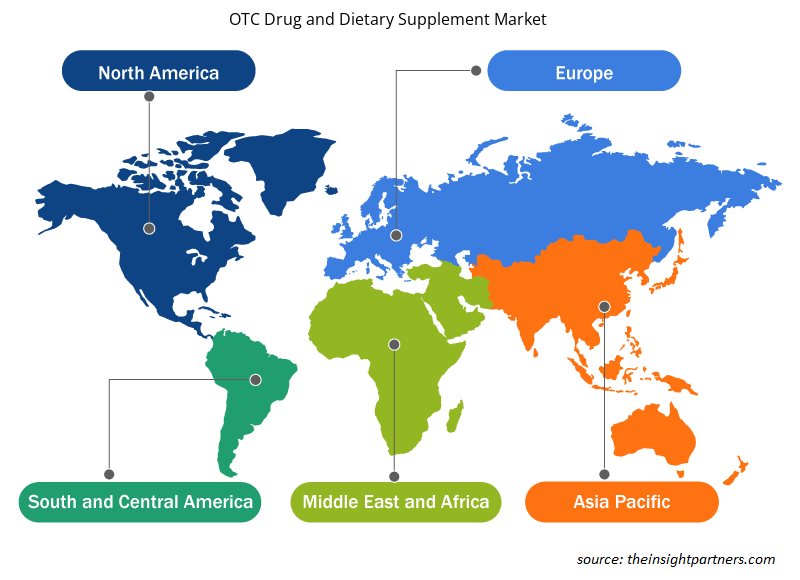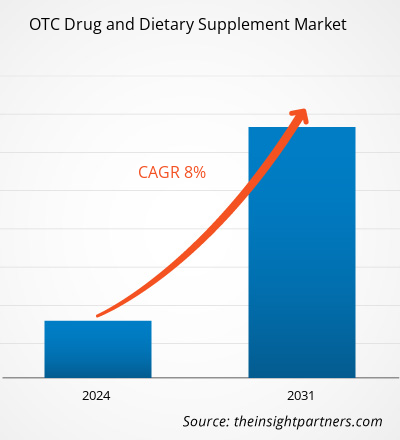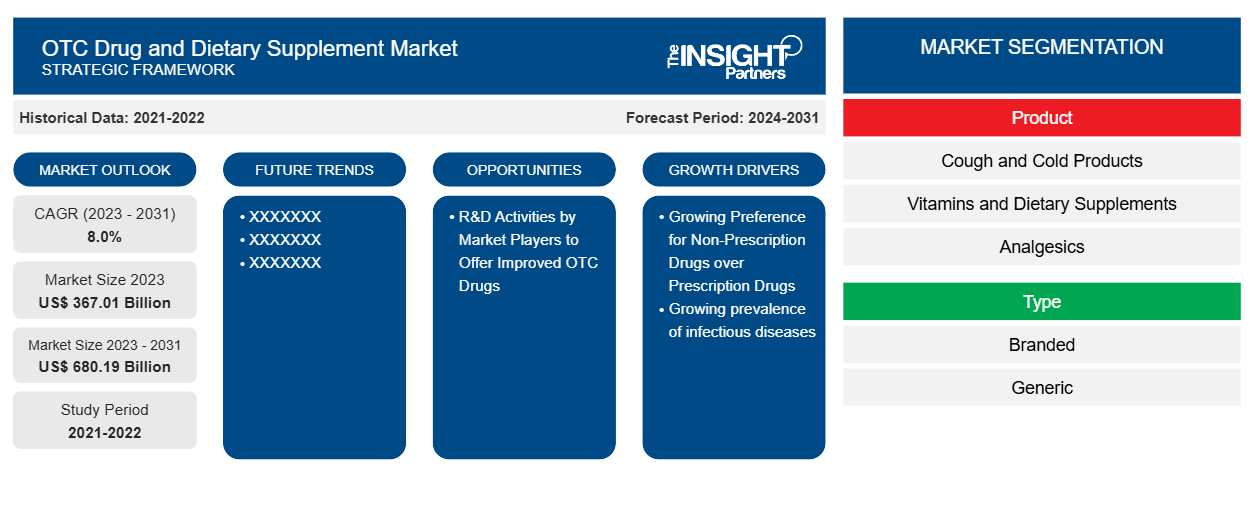Das Marktvolumen für rezeptfreie Arzneimittel und Nahrungsergänzungsmittel wurde im Jahr 2023 auf 367,01 Milliarden US-Dollar geschätzt und soll bis 2031 680,19 Milliarden US-Dollar erreichen; bis 2031 wird eine durchschnittliche jährliche Wachstumsrate von 8,0 % erwartet. Die Auswahl rezeptfreier Arzneimittel für leichte Erkrankungen wird voraussichtlich weiterhin ein wichtiger Trend auf dem Markt für rezeptfreie Arzneimittel und Nahrungsergänzungsmittel bleiben.
Marktanalyse für rezeptfreie Arzneimittel und Nahrungsergänzungsmittel
Der wachsende Schwerpunkt auf patientenzentrierter Versorgung, Fortschritte in der Gesundheitstechnologie, Kosteneffizienz von rezeptfreien Medikamenten und Nahrungsergänzungsmitteln sowie die zunehmende Präferenz für Telemedizin treiben das Wachstum des Marktes für rezeptfreie Medikamente und Nahrungsergänzungsmittel voran. Darüber hinaus treiben die zunehmende geriatrische Bevölkerung, die zunehmende häusliche Pflege und die zunehmende Verbreitung chronischer und infektiöser Krankheiten das Wachstum des Marktes für rezeptfreie Medikamente und Nahrungsergänzungsmittel voran.
Marktübersicht für rezeptfreie Arzneimittel und Nahrungsergänzungsmittel
Over-the-Counter-Medikamente (OTC) sind für allgemeine Zwecke der Öffentlichkeit erhältlich. OTC-Medikamente sind für verschiedene medizinische Symptome aufgrund von Erkrankungen wie Husten und Erkältungen, Durchfall, Sodbrennen, Verstopfung, Akne, Schmerzen und andere erhältlich. Auf der anderen Seite sind Nahrungsergänzungsmittel für Fitnesszwecke rezeptfrei erhältlich. Diese OTC-Medikamente und Nahrungsergänzungsmittel gibt es in zwei Arten, nämlich Marken- oder Generika.
Passen Sie diesen Bericht Ihren Anforderungen an
Sie erhalten kostenlos individuelle Anpassungen an jedem Bericht, einschließlich Teilen dieses Berichts oder einer Analyse auf Länderebene, eines Excel-Datenpakets sowie tolle Angebote und Rabatte für Start-ups und Universitäten.
-
Holen Sie sich die wichtigsten Markttrends aus diesem Bericht.Dieses KOSTENLOSE Beispiel umfasst eine Datenanalyse von Markttrends bis hin zu Schätzungen und Prognosen.
Treiber und Chancen auf dem Markt für rezeptfreie Arzneimittel und Nahrungsergänzungsmittel
Wachsende Präferenz für nicht verschreibungspflichtige Medikamente gegenüber verschreibungspflichtigen Medikamenten
Der zunehmende Druck der Regierung und der Verbraucher, die Preise zu senken, würde dazu beitragen, den Übergang von verschreibungspflichtigen zu rezeptfreien Medikamenten (Rx-to-OTC) zu beschleunigen. Ärzte befürworten die Verwendung rezeptfreier Medikamente bei Fieber, Erkältung/Husten und kleineren Beschwerden dieser Art weitgehend; darüber hinaus haben die Ärzte jedoch einige Vorbehalte. Obwohl es generische verschreibungspflichtige Medikamente gibt, die billiger sind als rezeptfreie Medikamente, sind die meisten rezeptfreien Medikamente billiger als verschreibungspflichtige Medikamente. Rezeptfreie Medikamente werden bevorzugt, weil sie leicht verfügbar und erschwinglicher sind und als natürlicher wahrgenommen werden. Die zunehmende Präferenz für rezeptfreie Medikamente gegenüber rezeptpflichtigen Medikamenten aufgrund ihrer Vorteile treibt das Wachstum des Marktes für rezeptfreie Medikamente und Nahrungsergänzungsmittel voran.
F&E-Aktivitäten von Marktteilnehmern zur Bereitstellung verbesserter OTC-Medikamente – eine Chance für den Markt für OTC-Medikamente und Nahrungsergänzungsmittel
Das Vertrauen der Kunden in OTC-Marken ermutigt Arzneimittelhersteller, immer mehr Forschungs- und Entwicklungsaktivitäten für Abführmittel, orale Antiseptika, Mittel gegen Sodbrennen, Raucherentwöhnungsmittel, Analgetika und Nahrungsergänzungsmittel sowie andere rezeptfrei erhältliche Produkte durchzuführen. Dies hat sie dazu veranlasst, ihre Herstellungs- und F&E-Aktivitäten auszuweiten. So eröffnete Novartis Consumer Health Inc. beispielsweise sein drittes globales Forschungs- und Entwicklungszentrum für OTC-Produkte in Mumbai, Indien. In vielen Industrieländern erweitert sich das Angebot an rezeptfrei erhältlichen Arzneimitteln für Verbraucher. Gleichzeitig steigt in Schwellenländern die Verwendung dieser Arzneimittel, während die entsprechenden Gesundheitssysteme stabil bleiben, sodass ein Wachstum bei OTC-Produkten erwartet wird. Wichtige Marktteilnehmer wenden Strategien wie Fusionen und Übernahmen an, um den Markt für OTC-Arzneimittel und Nahrungsergänzungsmittel zu entwickeln.
Segmentierungsanalyse des Marktberichts für rezeptfreie Arzneimittel und Nahrungsergänzungsmittel
Wichtige Segmente, die zur Ableitung der Marktanalyse für rezeptfreie Arzneimittel und Nahrungsergänzungsmittel beigetragen haben, sind Produkt, Typ, Form und Vertriebskanal.
- Basierend auf dem Produkt ist der Markt für rezeptfreie Arzneimittel und Nahrungsergänzungsmittel in Husten- und Erkältungsmittel, Vitamine und Nahrungsergänzungsmittel, Analgetika, Magen-Darm-Produkte, Schlafmittel, Mundpflegeprodukte, ophthalmische Produkte, Antazida, Damenhygiene und andere unterteilt. Das Segment Analgetika hatte im Jahr 2023 den größten Marktanteil.
- Der Markt für rezeptfreie Arzneimittel und Nahrungsergänzungsmittel ist nach Typ in Marken- und Generikaprodukte unterteilt. Das Generikasegment hatte im Jahr 2023 den größten Marktanteil.
- Nach Form ist der Markt in Tabletten, Kapseln, Pulver, Salben, Flüssigkeiten und Sonstiges unterteilt. Das Tablettensegment hatte im Jahr 2023 den größten Marktanteil.
- In Bezug auf die Vertriebskanäle ist der Markt segmentiert in Krankenhaus- und Einzelhandelsapotheken, Einzelhandelsgeschäfte, Online-Kanäle und andere. Das Segment Krankenhaus- und Einzelhandelsapotheken hielt im Jahr 2023 den größten Marktanteil.
Marktanteilsanalyse für rezeptfreie Arzneimittel und Nahrungsergänzungsmittel nach geografischen Gesichtspunkten
Der geografische Umfang des Marktberichts für rezeptfreie Arzneimittel und Nahrungsergänzungsmittel ist hauptsächlich in fünf Regionen unterteilt: Nordamerika, Asien-Pazifik, Europa, Naher Osten und Afrika sowie Süd- und Mittelamerika.
Nordamerika dominiert den Markt für rezeptfreie Medikamente und Nahrungsergänzungsmittel. In Nordamerika halten die USA den größten Anteil am Markt für rezeptfreie Medikamente und Nahrungsergänzungsmittel. Das Wachstum in Nordamerika ist gekennzeichnet durch eine hohe Verbreitung von Infektionskrankheiten, steigende staatliche Unterstützung für die Pharmaindustrie, steigende Gesundheitsausgaben, eine zunehmende Nutzung rezeptfreier Medikamente, eine stärkere Nutzung von Telegesundheitsdiensten, eine steigende Zahl von Dienstleistern und die Entwicklung von Gesundheitseinrichtungen. Andererseits ist die Nachfrage nach Nahrungsergänzungsmitteln in allen Altersgruppen in den USA viel höher.
Regionale Einblicke in den Markt für rezeptfreie Arzneimittel und Nahrungsergänzungsmittel
Die regionalen Trends und Faktoren, die den Markt für rezeptfreie Arzneimittel und Nahrungsergänzungsmittel im Prognosezeitraum beeinflussen, wurden von den Analysten von Insight Partners ausführlich erläutert. In diesem Abschnitt werden auch die Marktsegmente und die Geografie für rezeptfreie Arzneimittel und Nahrungsergänzungsmittel in Nordamerika, Europa, im asiatisch-pazifischen Raum, im Nahen Osten und Afrika sowie in Süd- und Mittelamerika erörtert.

- Erhalten Sie regionale Daten zum Markt für rezeptfreie Arzneimittel und Nahrungsergänzungsmittel
Umfang des Marktberichts zu rezeptfreien Arzneimitteln und Nahrungsergänzungsmitteln
| Berichtsattribut | Details |
|---|---|
| Marktgröße im Jahr 2023 | 367,01 Milliarden US-Dollar |
| Marktgröße bis 2031 | 680,19 Milliarden US-Dollar |
| Globale CAGR (2023 - 2031) | 8,0 % |
| Historische Daten | 2021-2022 |
| Prognosezeitraum | 2024–2031 |
| Abgedeckte Segmente |
Nach Produkt
|
| Abgedeckte Regionen und Länder |
Nordamerika
|
| Marktführer und wichtige Unternehmensprofile |
|
Marktteilnehmerdichte: Der Einfluss auf die Geschäftsdynamik
Der Markt für rezeptfreie Arzneimittel und Nahrungsergänzungsmittel wächst rasant. Dies wird durch die steigende Nachfrage der Endverbraucher aufgrund von Faktoren wie sich entwickelnden Verbraucherpräferenzen, technologischen Fortschritten und einem größeren Bewusstsein für die Vorteile des Produkts vorangetrieben. Mit der steigenden Nachfrage erweitern Unternehmen ihr Angebot, entwickeln Innovationen, um die Bedürfnisse der Verbraucher zu erfüllen, und nutzen neue Trends, was das Marktwachstum weiter ankurbelt.
Die Marktteilnehmerdichte bezieht sich auf die Verteilung der Firmen oder Unternehmen, die in einem bestimmten Markt oder einer bestimmten Branche tätig sind. Sie gibt an, wie viele Wettbewerber (Marktteilnehmer) in einem bestimmten Marktraum im Verhältnis zu seiner Größe oder seinem gesamten Marktwert präsent sind.
Die wichtigsten auf dem Markt für rezeptfreie Arzneimittel und Nahrungsergänzungsmittel tätigen Unternehmen sind:
- GlaxoSmithKline plc
- Sanofi
- Johnson & Johnson Services, Inc.
- Abbott
- AbbVie Inc
- Bausch Health Companies Inc
Haftungsausschluss : Die oben aufgeführten Unternehmen sind nicht in einer bestimmten Reihenfolge aufgeführt.

- Überblick über die wichtigsten Akteure auf dem Markt für rezeptfreie Arzneimittel und Nahrungsergänzungsmittel
Nachrichten und aktuelle Entwicklungen zum Markt für rezeptfreie Arzneimittel und Nahrungsergänzungsmittel
Der Markt für rezeptfreie Arzneimittel und Nahrungsergänzungsmittel wird durch die Erhebung qualitativer und quantitativer Daten aus Primär- und Sekundärforschung bewertet, die wichtige Unternehmensveröffentlichungen, Verbandsdaten und Datenbanken umfasst. Im Folgenden finden Sie eine Liste der Entwicklungen auf dem Markt für virale Antigene und Strategien:
- Emcure Pharmaceuticals hat mit seinem Produkt Galact den Einstieg in den rezeptfreien Markt (OTC) angekündigt. Angereichert mit der Wirksamkeit von Shatavari und sechs weiteren Kräutern wurde Galact sorgfältig formuliert, um die Muttermilchproduktion bei Müttern anzukurbeln. (Quelle: Nuffoods Spectrum, Pressemitteilung, 2024)
- McKesson hat sein Foster & Thrive-Sortiment an rezeptfreien Gesundheits- und Wellnessprodukten unter Eigenmarken auf den Markt gebracht. Nach Angaben des Unternehmens wird die neue Marke das Eigenmarkenportfolio von McKesson vereinheitlichen, das OTC-Produkte umfasst, die unter den Marken Health Mart und Sunmark verkauft werden. (Quelle: Bareback Media Pvt. Ltd, Pressemitteilung, 2023)
Marktbericht zu rezeptfreien Arzneimitteln und Nahrungsergänzungsmitteln – Umfang und Ergebnisse
Der Bericht „Marktgröße und Prognose für rezeptfreie Arzneimittel und Nahrungsergänzungsmittel (2021–2031)“ bietet eine detaillierte Analyse des Marktes, die die folgenden Bereiche abdeckt:
- Marktgröße und Prognose auf globaler, regionaler und Länderebene für alle wichtigen Marktsegmente, die im Rahmen des Projekts abgedeckt sind
- Marktdynamik wie Treiber, Beschränkungen und wichtige Chancen
- Wichtige Zukunftstrends
- Detaillierte PEST/Porters Five Forces- und SWOT-Analyse
- Globale und regionale Marktanalyse mit wichtigen Markttrends, wichtigen Akteuren, Vorschriften und aktuellen Marktentwicklungen
- Branchenlandschaft und Wettbewerbsanalyse, einschließlich Marktkonzentration, Heatmap-Analyse, prominenten Akteuren und aktuellen Entwicklungen
- Detaillierte Firmenprofile
- Historische Analyse (2 Jahre), Basisjahr, Prognose (7 Jahre) mit CAGR
- PEST- und SWOT-Analyse
- Marktgröße Wert/Volumen – Global, Regional, Land
- Branchen- und Wettbewerbslandschaft
- Excel-Datensatz
Aktuelle Berichte
Verwandte Berichte
Erfahrungsberichte
Grund zum Kauf
- Fundierte Entscheidungsfindung
- Marktdynamik verstehen
- Wettbewerbsanalyse
- Kundeneinblicke
- Marktprognosen
- Risikominimierung
- Strategische Planung
- Investitionsbegründung
- Identifizierung neuer Märkte
- Verbesserung von Marketingstrategien
- Steigerung der Betriebseffizienz
- Anpassung an regulatorische Trends























 Kostenlose Probe anfordern für - Markt für rezeptfreie Arzneimittel und Nahrungsergänzungsmittel
Kostenlose Probe anfordern für - Markt für rezeptfreie Arzneimittel und Nahrungsergänzungsmittel